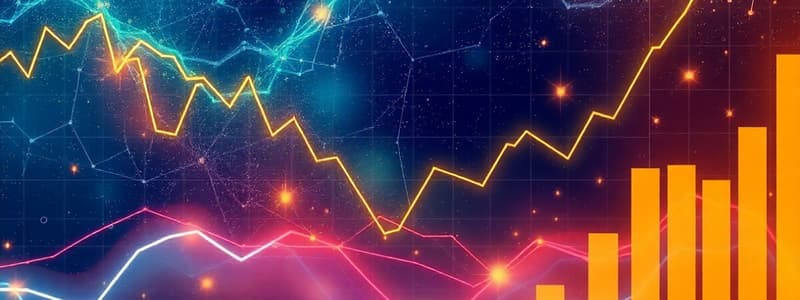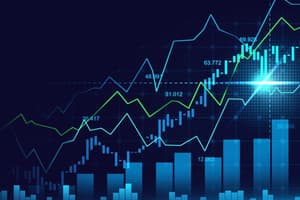Podcast
Questions and Answers
What is the primary goal of central banks in formulating monetary policy?
What is the primary goal of central banks in formulating monetary policy?
- To decrease the money supply
- To achieve price stability and full employment (correct)
- To increase exports
- To control international trade agreements
Which of the following describes quantitative easing (QE)?
Which of the following describes quantitative easing (QE)?
- Purchasing assets to inject liquidity without raising short-term interest rates (correct)
- Adjusting floating exchange rates
- Increasing short-term interest rates
- Selling government securities to decrease the money supply
What does a trade deficit indicate?
What does a trade deficit indicate?
- High foreign investment
- Balanced trade transactions
- Imports exceed exports (correct)
- Exports exceed imports
What is a characteristic of floating exchange rates?
What is a characteristic of floating exchange rates?
What does the Solow Growth Model primarily analyze?
What does the Solow Growth Model primarily analyze?
What does a trade surplus indicate about a country's economic situation?
What does a trade surplus indicate about a country's economic situation?
Which factor is seen as a driver of sustained economic growth in Endogenous Growth Theory?
Which factor is seen as a driver of sustained economic growth in Endogenous Growth Theory?
What economic issue does the term 'income inequality' refer to?
What economic issue does the term 'income inequality' refer to?
What does Gross Domestic Product (GDP) measure?
What does Gross Domestic Product (GDP) measure?
Which of the following correctly describes inflation?
Which of the following correctly describes inflation?
What is unemployment defined as?
What is unemployment defined as?
What characterizes economic growth?
What characterizes economic growth?
How is government spending used in fiscal policy?
How is government spending used in fiscal policy?
What is the primary purpose of taxes?
What is the primary purpose of taxes?
What signifies a budget deficit?
What signifies a budget deficit?
What do central banks use interest rates for?
What do central banks use interest rates for?
Flashcards
GDP
GDP
Monetary value of all final goods/services in a country in a period.
Inflation
Inflation
Persistent rise in general prices over time.
Unemployment
Unemployment
State of being without a job while actively seeking work.
Economic Growth
Economic Growth
Signup and view all the flashcards
Business Cycles
Business Cycles
Signup and view all the flashcards
Government Spending
Government Spending
Signup and view all the flashcards
Interest Rates
Interest Rates
Signup and view all the flashcards
Money Supply
Money Supply
Signup and view all the flashcards
Increased Money Supply
Increased Money Supply
Signup and view all the flashcards
Central Bank
Central Bank
Signup and view all the flashcards
Open Market Operations
Open Market Operations
Signup and view all the flashcards
Quantitative Easing (QE)
Quantitative Easing (QE)
Signup and view all the flashcards
Balance of Payments
Balance of Payments
Signup and view all the flashcards
Exchange Rates
Exchange Rates
Signup and view all the flashcards
Trade Deficit
Trade Deficit
Signup and view all the flashcards
Solow Growth Model
Solow Growth Model
Signup and view all the flashcards
Study Notes
Macroeconomic Concepts
- Gross Domestic Product (GDP): Measures the monetary value of all final goods and services produced within a country's borders in a specific time period. It's a key indicator of a nation's economic health. Different estimations of GDP can exist (nominal, real) depending on how inflation is accounted for.
- Inflation: A persistent increase in the general price level of goods and services in an economy over a period of time. It erodes the purchasing power of money. Measured using indices like the Consumer Price Index (CPI).
- Unemployment: The state of being without a job when actively seeking work. Different types exist (frictional, structural, cyclical). High unemployment is often associated with economic downturns.
- Economic Growth: An increase in the production of economic goods and services, typically measured by changes in real GDP or per capita GDP. Factors like technological progress and investment play key roles in driving growth.
- Business Cycles: Fluctuations in economic activity around a long-term growth trend, characterized by periods of expansion (growth) and contraction (recession). Recessions are typically marked by a significant decline in economic activity.
Fiscal Policy
- Government Spending: Expenditures by a government on goods, services, and transfer payments (like social security). Can be used to stimulate or dampen economic activity.
- Taxes: Monetary levies imposed by governments on individuals and businesses. Used to raise revenue and influence economic behavior. Different types exist (income tax, sales tax, etc.).
- Government Debt: The total accumulation of borrowed funds by a government that hasn't been repaid. Can be expressed as a percentage of GDP.
- Budget Deficits: When government spending surpasses government revenue in a given fiscal year. A deficit is often financed by borrowing.
- Expansionary Fiscal Policy: Increasing government spending or decreasing taxes to stimulate aggregate demand during a recession.
- Contractionary Fiscal Policy: Decreasing government spending or increasing taxes to cool down an overheated economy (high inflation).
Monetary Policy
- Interest Rates: Cost of borrowing money, directly influencing investment and consumer spending. Central banks often manage them to control inflation and stimulate economic growth.
- Money Supply: Total amount of money available in an economy. Influenced by actions of central banks. Increased money supply can lead to inflation.
- Central Banks: Institutions responsible for formulating and implementing monetary policy to achieve price stability and full employment. Examples include the Federal Reserve (US) and the Bank of England.
- Open Market Operations: Buying or selling government securities (bonds) by a central bank to influence the money supply.
- Quantitative easing (QE): A type of unconventional monetary policy central banks use where they inject liquidity into money markets by purchasing assets without raising short-term interest rates.
International Trade
- Balance of Payments: Sum of all transactions between a country and the rest of the world over a period. Comprises current account (exports, imports, income) and capital account.
- Exchange Rates: The value of one currency in terms of another. Floating exchange rates fluctuate according to market forces, while fixed exchange rates are pegged to another currency.
- Exports: Goods and services sold to other countries. An increase in exports is often good for a nation's economic performance.
- Imports: Goods and services bought from other countries. An increase in imports can cause a trade deficit.
- Trade Deficit: When a country's imports exceed its exports. A persistent trade deficit can have negative implications.
- Trade Surplus: When a country's exports exceed its imports. Having a trade surplus can be positive for a nation's balance of payments.
Economic Growth Models
- Solow Growth Model: A neoclassical model describing long-run economic growth. Explores how savings, population growth, and technological progress affect a country's long-run level of income.
- Endogenous Growth Theory: Explores how factors like research and development, education, and human capital can drive sustained economic growth in the long run.
- Foreign Direct Investment (FDI): Investment made by a company or individual in one country into business interests located in another country. A key element for economic development.
- Globalization: Increasing interconnectedness of national economies through trade, investment, and technological advancements. Has both benefits and costs.
Economic Challenges
- Poverty: Lack of sufficient income or resources to meet basic needs. Significant global and national concern.
- Income Inequality: Uneven distribution of income within a population. A challenge that can destabilize societies.
- Unemployment: A persistent unemployment rate presents significant economic and social problems and can hamper growth.
- Climate Change: The potential impact of climate change on global resource availability, and the economic sectors most likely to be affected.
- Political Instability: Political or social unrest can create instability that discourages investment and hinders economic growth.
Studying That Suits You
Use AI to generate personalized quizzes and flashcards to suit your learning preferences.




